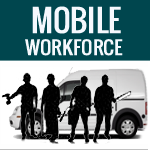As mobile technology permeates enterprise 
environments,more employees are looking
to utilize the devices to open up more
remote working opportunities and to
improve job efficiency.
While there are many typical factors that contribute
to the success of mobility,such as creating business
policies, there are some considerations that
are chronically overlooked when implementing
a mobile initiative.
Here are a few surprising mobile workforce management tips:
1. Drive interpersonal connections
One of the biggest problems with working remotely is that some employees can feel disjointed, and apart from the organization as a whole, which could negatively affect the organization’s bottom line. However, there are easy ways to bring workers together even when they’re not in the same room. Utilizing video conferencing and collaboration solutions will give employees the tools they need to communicate effectively with their peers. Instant messaging features will show who is available to talk and can be a faster method of reaching someone than email or calling, especially for a quick question. Some companies may bring in remote workers for a few weeks to train in order to indoctrinate them to the company’s culture, according to Workforce. This process will help the employee understand the organization’s procedures and get to know peers.
2. Generate performance data
If mobile working is a new concept for the business or if an individual is doing it on a trial basis, data is crucial to keeping track of the achieved productivity statistics. Many organizations want to see results from their investments, and if the management begins to question the feasibility of remote work, the information to prove the increased efficiency should be prepared. Gathering feedback from employees about what’s working and what requires improvement can also help the business make informed decisions without losing the productivity gains, according to Training Magazine contributor John Anderson. The data may show significant trends that can maximize benefits when deploying mobile solutions. This means that the reports collected will provide a better blueprint for companies to make change that will positively impact revenue.
3. Separate personal life from work
While doing business from home can be a good chance to take care of personal tasks, the organization should empower their employees to enjoy their free time outside of office hours. According to new research from Yast, 25 percent of mobile workers gave up their lunchtime for business purposes while 16 percent sacrificed time with family and friends to make up lost work time. These figures may be all too familiar to mobile employees across industries, making it necessary for the organization to supply the best tools to get the job done without giving up lunch or personal time. Utilizing unified communications software, like those from ShoreTel, can give businesses features that they need to have faster information sharing, and increased productivity during work hours.
Managing a mobile workforce can be challenging, however, with the proper tools, employees can better communicate and collaborate with each other. Utilizing UC and collaboration solutions will help workers be more efficient and productive to foster the company’s success.
Author Bio:
Jack McCarthy is content manager at ShoreTel, with duties that include writing and editing blogs, and developing and editing white papers, guide books, trend stories and Webinars. A veteran technology reporter and editor, McCarthy has worked at CRN, Infoworld, and IDG News Service, among other organizations. He holds a bachelor’s degree from Holy Cross College and master’s degrees from Tufts University and the Monterey Institute of International Studies.
